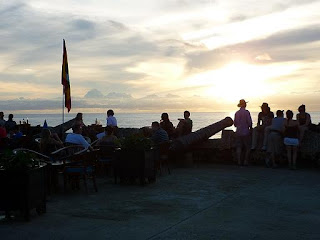Cartagena itself was originally a Zenu settlement which was a seafaring nation as well as a having substantial prowess on the battlefield. Although they didn't have metal weapons, their swords and spears of hardened wood as well as the poison tipped arows of considerable range made them formidable foes, and according to the Naval Museum, better armed than the Spaniards, with their short range blunderbusses and flimsy and relatively short steel swords. It took many years and many attempts for the Spaniards to drive the indigenous out of the settlement, and European diseases played a huge part in their destruction. Columbus' cartographer Juan de Rosa was an early casualty in one such encounter, slain by arrows. The Zenu were good gold artificers, as well as had extensive knowledge of irrigation, and they terraced the land to take advantage of the floodwaters of the rainy season, and then store it for the dry periods. Needless to say, the Spanish ignored this knowledge and laid out their city according to the usual colonial template, rendering them vulnerable to the vicissitudes of the weather and the seasons. The Naval Museum pays homage to the culture of the indigenous, and to conquistador founders with scenes from preColumbian life and early colonial times, in the curious quest for identity that marks Latin America. What was once to be eradicated is now celebrated, now that is no longer a threat and of course the Spanish language is dominant.
Cartagena was a depot for the plundered gold from the continent, before shipment back to Spain, which of course made it a ripe target for English and French pirates and buccaneers. Fortifications were continously improved in the hope of stymying these raids, eventually the Spanish gave up and sent the looted gold the long way round via the Cape Horn, seeing the threat of shipwreck due to the terrible seas and storms as the lesser evil. The sacking of Cartagena by Drake was a particularly amusing story, as well as a tale of brilliant military cunning, landing a large advance party under cover of darkness to overcome the defences. The governor fled, and the hapless bishop could not come up with the figure Drake demanded (400 000 ducats), saying the were only 107 000 gold ducats in the town. this Drake refused to believe, and the bishop was able to come up with more gold after Drake fired a cannonball into his beloved cathedral. I can't remember the final figure that Drake made off with, but it was considerably more, maybe 250 000. However, Drake reported to Queen Elizabeth I the original figure of the bishop 107 000 ducats, and kept the balance himself. They were all crooks, the Spanish plunderers and the English and French adventurers, whilst the Indians were crushed and looted. A terrible story of opportunism.

Calle Media Luna towards the Central Park on the way to the historic centre

A fruit vendor just outside Getsemani

The chaotic street market just outside Getsemani

A coffee vendor taking a break. The coffee is very sweet and weak, they call it "tinto"

Plaza Trinidad, just down the road from Hotel Casa Familiar, a real magnet for street life at night, with people dancing to an impromptu sound system

Detail of the house to the left above, made of hewn blocks of coral

Castillo San Felippe, one of the series of forts to designed to defend Cartagena from raids. It was only overcome once, and that was before it was completed. Other defences included stringing chains between the island and the mainland, cross firing cannons into the waterways, and a submerged wall to cause vessels to be stranded and easy cannon targets.

Colourful buildings on the edge of Getsemani

Calle San Andreas, Getsemani

The knocker of the Palacio Inqisicion in the Centro Historico. No way was I paying to go in

Plaza Santa Domingo with reclining Botelli (?) nude. Full of touristst and cafés

Zenu gold artifacts


Zenu gold artifacts, often alloyed with copper to mgive a reddish effect, known as "Tumbaga"


Zenu gold artifacts

Zenu gold artifacts

Zenu earings, symbolising the canl system and the interconnectedness of life on earth and also heaven.

Contemporary sculpture outside Centro Historico representing the disruption in a life which has experienced acute trauma or loss, the void needing to be filled by humanity. I greatly enjoyed the contemporary art museum.

The beautiful people enjoying the sunset on the old fortifications surrounding the Centro Historico at the Café del Mar

No hay comentarios:
Publicar un comentario